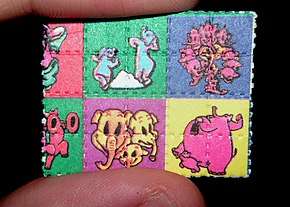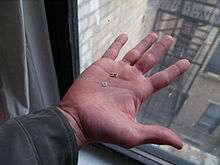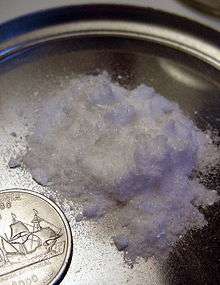Psychedelic drug

Psychedelics are a class of drug whose primary action is to trigger psychedelic experiences via serotonin receptor agonism,[2] causing thought and visual/auditory changes, and altered state of consciousness.[3] Major psychedelic drugs include mescaline, LSD, psilocybin, and DMT. Studies show that psychedelics are physiologically safe and do not lead to addiction. Studies conducted using psilocybin in a psychotheraputic setting reveal that psychedelic drugs may assist with treating alcohol and nicotine addiction.[4]
Differing with other psychoactive drugs, such as stimulants and opioids, psychedelics tend to qualitatively alter ordinary conscious experience. Whereas stimulants cause energized feelings and opioids produce a relaxed euphoric state, the psychedelic experience is often compared to non-ordinary forms of consciousness such as trance, meditation, yoga, religious ecstasy, dreaming and even near-death experiences. Most psychedelic drugs fall into one of the three families of chemical compounds: tryptamines, phenethylamines, or lysergamides.
Many psychedelic drugs are illegal worldwide under the UN conventions, occasionally excepting use in a religious or research context. Despite these controls, recreational use of psychedelics is common.[5][6]
Origin of term
The term psychedelic is derived from the Greek words ψυχή (psyche, "soul, mind") and δηλείν (delein, "to manifest"), hence "soul-manifesting", the implication being that psychedelics can access the soul and develop unused potentials of the human mind.[7] The word was coined in 1956 by British psychiatrist, Humphry Osmond, the spelling loathed by American ethnobotanist, Richard Schultes, but championed by the American psychologist, Timothy Leary.[8]
Aldous Huxley had suggested to Humphry Osmond in 1956 his own coinage phanerothyme (Greek "phaneroein-" visible + Greek "thymos" soul, thus "visible soul").[9] Recently, the term entheogenic has come into use to denote the use of psychedelic drugs in a religious/spiritual/mystical context.
Traditional use
Psychedelics have a long history of traditional use in medicine and religion, for their perceived ability to promote physical and mental healing. In this context, they are often known as entheogens. Native American practitioners using mescaline-containing cacti (most notably peyote, San Pedro, and Peruvian torch) have reported success against alcoholism, and Mazatec practitioners routinely use psilocybin mushrooms for divination and healing. Ayahuasca, which contains the potent psychedelic DMT, is used in Peru and other parts of South America for spiritual and physical healing as well as in religious festivals.
Examples

Classical or serotonergic psychedelics (agonists for the 5-HT2A serotonin receptors) include LSD (also known as "acid"), psilocin (the active constituent of psilocybin mushrooms, commonly known as "magic mushrooms" or "shrooms"), mescaline (the active constituent of peyote), and DMT (the active constituent of ayahuasca and an endogenous compound produced in the human body).
Pharmacological classes and effects
Serotonergic psychedelics (5-HT2A receptor agonists)
This class of psychedelics includes the classical hallucinogens, including the lysergamides like LSD and LSA, tryptamines like psilocybin and DMT, and phenethylamines like mescaline and 2C-B. Many of these psychedelics cause remarkably similar effects, despite their different chemical structure. However, many users report that the three families have subjectively different qualities in the "feel" of the experience, which are difficult to describe. At lower doses, these include sensory alterations, such as the warping of surfaces, shape suggestibility, and color variations. Users often report intense colors that they have not previously experienced, and repetitive geometric shapes are common. Higher doses often cause intense and fundamental alterations of sensory perception, such as synesthesia or the experience of additional spatial or temporal dimensions.[10] Some compounds, such as 2C-B, have extremely tight "dose curves", meaning the difference between a non-event and an overwhelming disconnection from reality can be very slight. There can be very substantial differences between the drugs, however. For instance, 5-MeO-DMT rarely produces the visual effects typical of other psychedelics and ibogaine (a 'complex tryptamine') is also an NMDA receptor antagonist and κ-opioid receptor agonist in addition to being an agonist for the 5-HT2A receptors, resulting in dissociative effects as well (see dissociatives below). Research published in journal "Cell Reports" states that Psychedelic drugs promote neural plasticity in rats and flies.[11]
Almost all antidepressant drugs, especially atypical ones like mirtazapine and trazodone, are 5-HT2A antagonists, from moderate to very strong, and thus often totally disrupts psychedelic effects. Furthermore, persons on chronic antidepressive medications virtually can't get any effects from serotonergic psychedelic drugs even after discontinuing antidepressant drugs.
Empathogen-entactogens (serotonin releasers)
The empathogen-entactogens are phenethylamines of the MDxx class such as MDMA, MDEA, and MDA. Their effects are characterized by feelings of openness, euphoria, empathy, love, heightened self-awareness, and by mild audio and visual distortions (an overall enhancement of sensory experience is often reported). Their adoption by the rave subculture is probably due to the enhancement of the overall social and musical experience. MDA is atypical to this experience, often causing hallucinations and psychedelic effects in equal profundity to the chemicals in the 5-HT2A agonist category, but with substantially less mental involvement, and is both a serotonin releaser and 5-HT2A receptor agonist.
Dissociatives
NMDA antagonists
Certain dissociative drugs acting via NMDA antagonism are known to produce what some might consider psychedelic effects. The main differences between dissociative psychedelics and serotonergic hallucinogens are that the dissociatives cause more intense derealization and depersonalization.[12] For example, ketamine produces sensations of being disconnected from one's body and that the surrounding environment is unreal, as well as perceptual alterations seen with other psychedelics.[13]
Other
Salvia divinorum is a dissociative that is sometimes classified as an atypical psychedelic. The active molecule in the plant, salvinorin A, is a kappa opioid receptor agonist, working on a part of the brain that deals with pain. Activation of this receptor is also linked to the dysphoria sometimes experienced by users of opioids either therapeutically or recreationally. An unusual feature of S. divinorum is its high potency (dosage is in the microgram range) and extremely disorienting effects, which often include "entity contact", complete loss of reality-perception and user's experiencing their consciousness as being housed in different objects e.g. a pane of glass or a pencil. Additionally, ibotenic acid and muscimol, the active constituents of Amanita muscaria, may be regarded as psychedelic, dissociative or deliriant.
Psychedelics and the law
Despite many psychedelic drugs being non-addictive[14] and there being no evidence to support long term harm on mental health[15] many of these drugs have been declared illegal under the UN Convention on Psychotropic Substances of 1971. In addition, many countries have analogue acts that automatically forbid any drugs sharing similar chemical structures to common illicit substances regardless of whether they are harmful.
See also
- Ayahuasca
- Bwiti
- Dimethyltryptamine
- Dissociative drug
- Concord Prison Experiment
- Entheogen
- Freedom of thought
- God in a Pill?
- Hallucinogen
- Hallucinogenic fish
- Hallucinogenic plants in Chinese herbals
- Hard and soft drugs
- Ibogaine
- List of psychedelic drugs
- List of psychedelic plants
- Lysergic acid diethylamide
- Marsh Chapel Experiment
- Morning glory
- Mystical psychosis
- Peyote
- Psilocybin mushroom
- Psychedelia
- Psychedelic art
- Psychedelic experience
- Psychedelic microdosing
- Psychedelic music
- Psychedelic therapy
- Psychedelics in problem-solving experiment
- Serotonergic psychedelic
- Set and setting
- Tabernanthe iboga
- War on Drugs
Categories
Notes
- ↑ "Peyote San Pedro Cactus – Shamanic Sacraments". D.M.Taylor.
- ↑ "Serotonin and Hallucinogens". Neuropsychopharmacology Reviews. 21: 16S–23S. doi:10.1016/S0893-133X(98)00135-3.
- ↑ Psychedelic drugs induce 'heightened state of consciousness', brain scans show, guardian.com. Retrieved: 23.04.2017.
- ↑ Nichols, David (April 2016). "Psychedelics". Pharmacological Reviews. 68 (2): 264. Retrieved 10 November 2017.
- ↑ Krebs TS, Johansen PØ (28 March 2013). "Over 30 million psychedelic users in the United States". F1000Research. 2. doi:10.12688/f1000research.2-98.v1. ISSN 2046-1402. PMC 3917651. PMID 24627778.
- ↑ Garcia-Romeu A, Kersgaard B, Addy PH (August 2016). "Clinical applications of hallucinogens: A review". Experimental and Clinical Psychopharmacology. 24 (4): 229–268. doi:10.1037/pha0000084. ISSN 1936-2293. PMC 5001686. PMID 27454674.
- ↑ A. Weil, W. Rosen. (1993), From Chocolate To Morphine:Everything You Need To Know About Mind-Altering Drugs.New York, Houghton Mifflin Company. p. 93
- ↑ W. Davis (1996), "One River: Explorations and Discoveries in the Amazon Rain Forest". New York, Simon and Schuster, Inc. p. 120
- ↑ iia700700.us.archive.org
- ↑ Luke, D. (2010). "Rock art or Rorschach: Is there more to entoptics than meets the eye?". Time and Mind. 3: 9–28. doi:10.2752/175169710x12549020810371.
- ↑ "Psychedelic drugs promote neural plasticity in rats and flies". ScienceDaily. Retrieved 2018-08-08.
- ↑ Vollenweider FX, Geyer MA. (2001) A systems model of altered consciousness: integrating natural and drug-induced psychoses. Brain Res Bull. 56: 495–507.
- ↑ Pomarol-Clotet, E; Honey, GD; Murray, GK; Corlett, PR; Absalom, AR; Lee, M; McKenna, PJ; Bullmore, ET; Fletcher, PC (2006). "Psychological effects of ketamine in healthy volunteers. Phenomenological study". Br J Psychiatry. 189: 173–179. doi:10.1192/bjp.bp.105.015263. PMC 3838932.
- ↑ Lüscher, Christian; Ungless, Mark (Nov 2006). "The Mechanistic Classification of Addictive Drugs". PLoS Med. 3 (11): e437. doi:10.1371/journal.pmed.0030437. PMC 1635740. PMID 17105338. Retrieved 2 June 2015.
- ↑ Krebs, Teri; Johansen, Pål-Ørjan (August 19, 2013). "Psychedelics and Mental Health: A Population Study". PLOS ONE. 8: e63972. doi:10.1371/journal.pone.0063972. PMC 3747247. PMID 23976938. Retrieved 2 June 2015.
External links
| Wikiquote has quotations related to: Psychedelics |
| Wikimedia Commons has media related to Psychedelics. |
- Scholarly bibliography on psychedelic drug use in the history of psychology
- WWW Psychedelic Bibliography – A searchable database with full text of many scientific articles on psychedelics
- Magic Mushrooms and Reindeer – Weird Nature. A short video on the use of Amanita muscaria mushrooms by the Sami people and their reindeer produced by the BBC.
- People on Psychedelics. A collection of people who have spoken openly about psychedelics.
- Manual for Ibogaine Therapy Contributing Authors : Marc Emery, Geerte Frenken, Sara Glatt, Brian Mariano, Karl Naeher, Dr. Martin Polanco, Marko Resinovic, Nick Sandberg, Eric Taub, Samuel Waizmann and Hattie Wells
- Trips Beyond Addiction Living Hero Radio Show and Podcast special. With Dimitri Mobengo Mugianis, Bovenga Na Muduma, Clare S. Wilkins, Brad Burge, Tom Kingsley Brown, Susan Thesenga, Bruce K. Alexander, PhD ~ the voices of ex-addicts, researchers from The Multidisciplinary Association for Psychedelic Studies and Ibogaine/Iboga/Ayahuasca treatment providers sharing their experiences in breaking addiction with native medicines. Jan 2013
- ERIE (Entheogenic Research, Integration, and Education) 501(c)(3) provides support to individuals navigating their entheogenic integration process.
